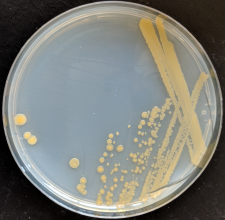Host Basics_ Microbacterium testaceum

An Introduction to Your Host Bacteria: Microbacterium testaceum
In this course, you will be isolating bacteriophage that infect the bacterium Microbacterium testaceum (M. testaceum). You will use a strain called M. testaceum SEA B-24232 that is made available to you from the Agricultural Research Service of USDA. This is your “host” for phage isolation.
M. testaceum is one of more than 90 species that make up the genus Microbacterium, classified within the phylum Actinobacteria. Microbacteria are gram-positive rod-shaped bacteria that are slightly smaller than typical rod-shaped bacteria, hence the name microbacteria. Microbacteria have been isolated from soil, water, and plants. Microbacteria have also been isolated from cheese rinds, where it may contribute to the flavor profile.
M. testaceum will grow and divide on many nutrient-rich media, and at temperatures ranging from room temperature (22 ˚C) to 37 ˚C. In your research, you will grow M. testaceum on PYCa media at 30 ˚C. Under these conditions, M. testaceum grows rapidly and it typically takes about 2 – 3 days for an individual cell to form a colony on an agar plate. However, when preparing a bacterial lawn,
you can start by adding many bacterial cells (e. g., 107 or more) so that a lush lawn grows within 24 hours. At room temperature (~ 22 ˚C), M. testaceum divides more slowly and typically requires an additional 24 hours to form either a colony or a lawn on plates. For reproducibility of experiments, it is important that cultures used for a given set of experiments be prepared at the same temperature.
M. testaceum colonies are tan to yellow in color, smooth and glossy (Figure 4.0-4). When incubated for prolonged periods, or when grown at room temperature, the color of the colonies are a brighter yellow. A liquid culture of M. testaceum inoculated from a single colony will take 24 - 48 hours to form a saturated liquid culture, exhibiting a tan to yellow color, which intensifies with prolonged incubation or when grown at room temperature. The strain you will work with, M. testaceum SEA B-24232, is not inhibited by the antifungal cyclohexamide. Therefore, cycloheximide can be added to the growth media to prevent other microorganisms from growing in
your cultures.
On average, 20 % of attempts to isolate phage from soil by enrichment with M. testaceum yield phage.
 |
|---|
Figure 4.0-4. Microbacterium testaceum growing on an agar plate. |
If you are using this bacterium as your host for phage isolation, refer back to the list below for the specific growth and culture requirements for your experiments.
Growth media: PYCa
Growth temperature: 30 ˚C
Antimicrobials: cycloheximide (10 μg/ml)
Phage Buffer: 10 mM Tris (pH 7.5), 10 mM MgSO4, 68 mM NaCl, 1 mM CaCl2, (10% glycerol, optional)
Restriction Enzymes: HaeIII, MseI, NspI, and SacII.
Note: Isoschizomers, which are different restriction enzymes that recognize the same DNA
sequence, may be used in place of any of the enzymes listed above.